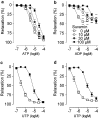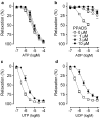Pharmacological characterization of nucleotide P2Y receptors on endothelial cells of the mouse aorta
- PMID: 15997227
- PMCID: PMC1576272
- DOI: 10.1038/sj.bjp.0706326
Pharmacological characterization of nucleotide P2Y receptors on endothelial cells of the mouse aorta
Abstract
Nucleotides regulate various effects including vascular tone. This study was aimed to characterize P2Y receptors on endothelial cells of the aorta of C57BL6 mice. Five adjacent segments (width 2 mm) of the thoracic aorta were mounted in organ baths to measure isometric force development. Nucleotides evoked complete (adenosine 5' triphosphate (ATP), uridine 5' triphosphate (UTP), uridine 5' diphosphate (UDP); >90%) or partial (adenosine 5' diphosphate (ADP)) relaxation of phenylephrine precontracted thoracic aortic rings of C57BL6 mice. Relaxation was abolished by removal of the endothelium and was strongly suppressed (>90%) by inhibitors of nitric oxide synthesis. The rank order of potency was: UDP approximately UTP approximately ADP>adenosine 5'-[gamma-thio] triphosphate (ATPgammaS)>ATP, with respective pD2 values of 6.31, 6.24, 6.22, 5.82 and 5.40. These results are compatible with the presence of P2Y1 (ADP>ATP), P2Y2 or P2Y4 (ATP and UTP) and P2Y6 (UDP) receptors. P2Y4 receptors were not involved, since P2Y4-deficient mice displayed unaltered responses to ATP and UTP. The purinergic receptor antagonist suramin exerted surmountable antagonism for all agonists. Its apparent pKb for ATP (4.53+/-0.07) was compatible with literature, but the pKb for UTP (5.19+/-0.03) was significantly higher. This discrepancy suggests that UTP activates supplementary non-P2Y2 receptor subtype(s). Further, pyridoxal-phosphate-6-azophenyl-2'-4'-disulphonic acid (PPADS) showed surmountable (UTP, UDP), nonsurmountable (ADP) or no antagonism (ATP). Finally, 2'-deoxy-N6-methyladenosine3',5'-bisphosphate (MRS2179) inhibited ADP-evoked relaxation only. Taken together, these results point to the presence of functional P2Y1 (ADP), P2Y2 (ATP, UTP) and P2Y6 (UDP) receptors on murine aorta endothelial cells. The identity of the receptor(s) mediating the action of UTP is not fully clear and other P2Y subtypes might be involved in UTP-evoked vasodilatation.
Figures







Similar articles
-
Endothelium-dependent relaxation evoked by ATP and UTP in the aorta of P2Y2-deficient mice.Br J Pharmacol. 2006 Mar;147(5):569-74. doi: 10.1038/sj.bjp.0706642. Br J Pharmacol. 2006. PMID: 16415908 Free PMC article.
-
Characterization by antagonists of P2-receptors mediating endothelium-dependent relaxation in the rat aorta.Naunyn Schmiedebergs Arch Pharmacol. 1997 Nov;356(5):641-52. doi: 10.1007/pl00005101. Naunyn Schmiedebergs Arch Pharmacol. 1997. PMID: 9402045
-
Nucleotide-mediated relaxation in guinea-pig aorta: selective inhibition by MRS2179.Br J Pharmacol. 2002 Jan;135(2):537-45. doi: 10.1038/sj.bjp.0704476. Br J Pharmacol. 2002. PMID: 11815389 Free PMC article.
-
Pharmacological profiles of cloned mammalian P2Y-receptor subtypes.Pharmacol Ther. 2006 Jun;110(3):415-32. doi: 10.1016/j.pharmthera.2005.08.014. Epub 2005 Oct 28. Pharmacol Ther. 2006. PMID: 16257449 Review.
-
Molecular pharmacology of P2Y-receptors.Naunyn Schmiedebergs Arch Pharmacol. 2000 Nov;362(4-5):310-23. doi: 10.1007/s002100000310. Naunyn Schmiedebergs Arch Pharmacol. 2000. PMID: 11111826 Review.
Cited by
-
Endothelium-dependent relaxation evoked by ATP and UTP in the aorta of P2Y2-deficient mice.Br J Pharmacol. 2006 Mar;147(5):569-74. doi: 10.1038/sj.bjp.0706642. Br J Pharmacol. 2006. PMID: 16415908 Free PMC article.
-
ATP mediates flow-induced NO production in thick ascending limbs.Am J Physiol Renal Physiol. 2012 Jul 15;303(2):F194-200. doi: 10.1152/ajprenal.00504.2011. Epub 2012 Apr 11. Am J Physiol Renal Physiol. 2012. PMID: 22496412 Free PMC article.
-
Purinergic Signaling During Hyperglycemia in Vascular Smooth Muscle Cells.Front Endocrinol (Lausanne). 2020 May 22;11:329. doi: 10.3389/fendo.2020.00329. eCollection 2020. Front Endocrinol (Lausanne). 2020. PMID: 32528416 Free PMC article. Review.
-
Uridine adenosine tetraphosphate induces contraction and relaxation in rat aorta.Vascul Pharmacol. 2008 Apr-Jun;48(4-6):202-7. doi: 10.1016/j.vph.2008.03.003. Epub 2008 Mar 28. Vascul Pharmacol. 2008. PMID: 18467183 Free PMC article.
-
P2Y12 Receptor Antagonist Clopidogrel Attenuates Lung Inflammation Triggered by Silica Particles.Front Pharmacol. 2020 Mar 18;11:301. doi: 10.3389/fphar.2020.00301. eCollection 2020. Front Pharmacol. 2020. PMID: 32256366 Free PMC article.
References
-
- ABBRACCHIO M.P., BOEYNAEMS J.M., BARNARD E.A., BOYER J.L., KENNEDY C., MIRAS-PORTUGAL M.T., KING B.F., GACHET C., JACOBSON K.A., WEISMAN G.A., BURNSTOCK G. Characterization of the UDP-glucose receptor (re-named here the P2Y14 receptor) adds diversity to the P2Y receptor family. Trends Pharmacol. Sci. 2003;24:52–55. - PMC - PubMed
-
- BENY J.L. Characterization of purine receptors in mouse thoracic aorta. J. Cardiovasc. Pharmacol. 2004;44:171–177. - PubMed
-
- BOARDER M.R., HOURANI S.M. The regulation of vascular function by P2 receptors: multiple sites and multiple receptors. Trends Pharmacol. Sci. 1998;19:99–107. - PubMed
Publication types
MeSH terms
Substances
LinkOut - more resources
Full Text Sources
Miscellaneous

